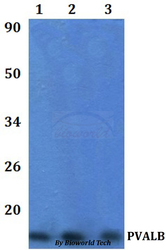Antibody data
- Antibody Data
- Antigen structure
- References [0]
- Comments [0]
- Validations
- Western blot [1]
Submit
Validation data
Reference
Comment
Report error
- Product number
- BS61332 - Provider product page

- Provider
- Bioworld Technology, Inc
- Product name
- PVALB polyclonal antibody
- Antibody type
- Polyclonal
- Antigen
- A synthetic peptide corresponding to residues in Human PVALB.
- Description
- The family of EF-hand type Ca2+-binding proteins includes calbindin (previously designated vitamin D-dependent Ca2+-binding protein), S-100Ï« and ÉÇ, calgranulins A (also designated MRP8), B (also designated MRP14) and C (S-100 like proteins) and the parvalbumin family members, including parvalbumin Ï« and parvalbumin ÉÇ, also designated oncomodulin (OCM). Structurally and evolutionarily conserved, parvalbumin Ï« and OCM proteins are distinct in expression and function. Parvalbumin Ï«, also designated parvalbumin (PV), is most abundantly expressed in fast-contracting muscles with lower expression levels in brain and some endocrine tissues, including kidney and parathyroid. Research indicates that parvalbumin Ï« plays a significant role in muscle relaxation. OCM was originally thought to have expression restricted to neoplastic tissues, early embryonic cells and certain tumor cell lines. Recent research shows that OCM is also expressed and secreted by macrophages where, in the retina it binds to retinal ganglion cells (RGCs) and functions to promote axon regeneration. OCM has also been detected in the auditory sensory cells of the organ of Corti in mammals. In humans, two different loci on chromosome 7 have been identified as OCM and OCM-like (LOC4951). These genes encode proteins 109 amino acids in length which share 99% sequence identity.
- Reactivity
- Human, Mouse, Rat
- Host
- Rabbit
- Isotype
- IgG
- Vial size
- 100ul
- Concentration
- 1 mg/ml
- Storage
- Store at 4°C short term. Aliquot and store at -20°C long term. Avoid freeze-thaw cycles.
No comments: Submit comment
Supportive validation
- Submitted by
- Bioworld Technology, Inc (provider)
- Main image

- Experimental details
- Western blot (WB) analysis of PVALB pAb at 1:500 dilution Lane1:HEK293T whole cell lysateLane2:The Muscle tissue lysate of Mouse Lane3:The Muscle tissue lysate of Rat
 Explore
Explore Validate
Validate Learn
Learn Western blot
Western blot